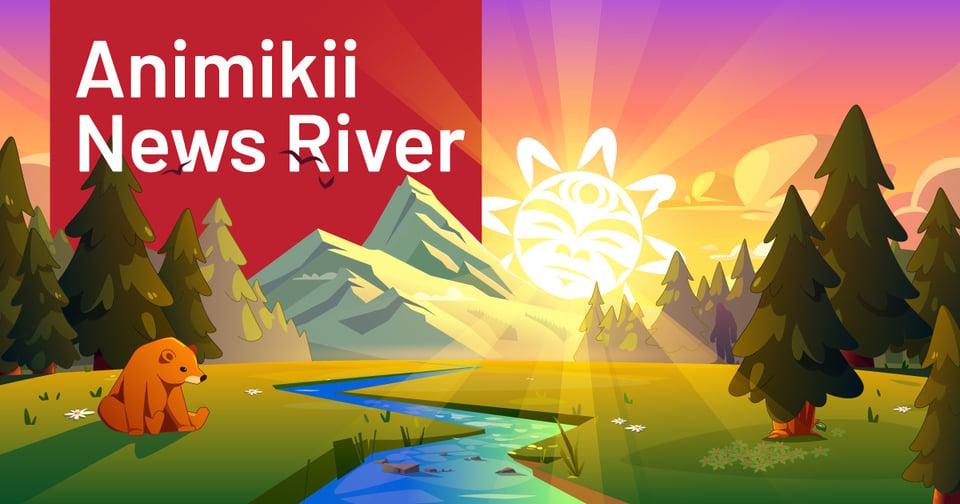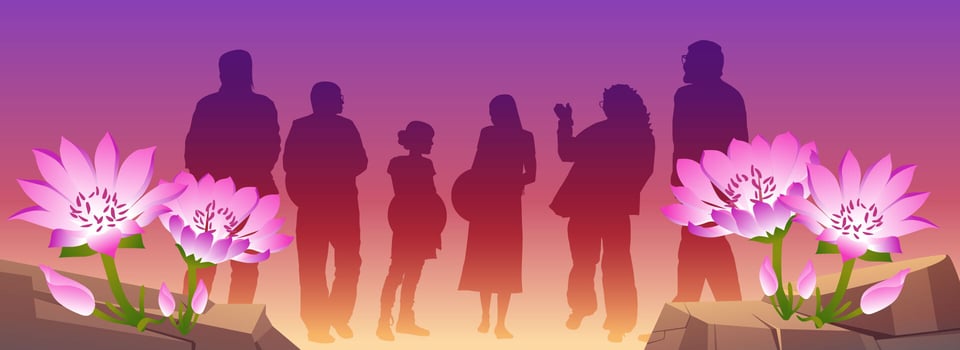Revitalize a language and reconnect communities

Boozhoo News River Readers,
Every week, we hand-pick the most important stories in Indigenous innovation, research, and culture. Stay connected to what matters.
If you enjoyed the stories in this week’s News River - invite others to join the conversation - forward this email to a friend or colleague!
This week’s stories include:
An article shares how an Indigenous computer scientist is walking in two worlds, using AI to preserve threatened languages.
The release of a new guide for journalists reporting on Indigenous and minoritized languages, language endangerment, and language revitalization.
A story about the hybrid solutions that northern, Indigenous, rural and remote communities often devise to access high-speed connectivity in Canada.
Feature

Put your language first, your language knows the way
The big picture: Christopher Parkin and LaRae Wiley recently delivered a keynote presentation at the annual Reawakening Our Language Gathering hosted by Doig River First Nation. The couple are co-founders of the Salish School of Spokane as well as the Indigenous Language Fluency Transfer System, created alongside the late master speaker Sʕamtíc̓aʔ (Sarah) Peterson, to bring the n̓səl̓xčin̓ language back to their family. Through this work, they’ve shown how critically endangered language communities can create fluency transfer systems that document the rich cultural landscape of their language. And when they do - it establishes a strong foundation for successful language revitalization work.
Why it matters: When critically endangered language communities are using strategies that do not match the level of endangerment of their language, they tend to use up their limited resources, providing community language services that do not train or support new advanced fluent speakers of their language. Severely endangered languages survive by creating adult fluent speakers who raise their children within the language, and by creating a community that engages families in their language culture.
Key points:
What young people need most to do well, is to have a strong sense of identity rooted in place and culture. Each endangered language embodies unique local knowledge of the cultures and natural systems in the region in which it was spoken. Language is the foundation of cultural identity, and cultural identity is the foundation of human happiness.
Successful language revitalization is relational and requires community. The systems of care required for language revitalization benefit people across multiple domains of their lives. Effective language revitalization increases physical and mental health, inter-generational relationships, school success, cultural engagement, employment, etc.
All other agendas are encompassed in the work of fluency transfer: stories, culture, material production. Teach enough adults to become fluent teachers, and ongoing language learning efforts can be paired with other activities to help address substance misuse, trauma healing and governance.
What they’re saying:
“Using the Indigenous Language Fluency Transfer System, it takes 18 months for someone with zero language to reach fluency. To become an adult fluent speaker, you don't need to learn the meta knowledge about your language, you don’t need a linguistics degree, you need to listen to and start speaking in your language.” Christopher Parkin, Principal and Business Manager at Salish School of Spokane.
“I was hooked. I thought, ‘This is magic.’” Ḵudeishéex̱ Esquiro, community co-ordinator at the Children Of The Taku Society. “By the end of that training, I taught my first immersion lesson for an hour-and-a-half with no English,” said Ḵudeishéex̱. “Before that time, I had zero Tlingit language.”
What’s next: Registration is now open for the 2025 Summer Immersion Symposium, July 17-18 in Spokane, WA. This training is for Indigenous language communities interested in building a fluency transfer system and/or engaging in immersion schooling.
The Salish School of Spokane is a registered non-profit. Support their capital campaign for the upcoming school year and also the construction of a new 20,000 square-foot school facility along the Spokane River.
Learn more: The audio recording and textbooks used in the n̓səl̓xčin̓ fluency transfer system are available for free on this curriculum and resources web site.
Curated Articles:
Michael Running Wolf leads artificial-intelligence initiatives to revive lost languages and empower Indigenous people. In many instances, one challenge these groups face is a lack of fluent speakers of Indigenous languages to both teach the next generation and to help train AI language models. Although children once learnt their ancestral languages at home, they now mostly engage with languages in the classroom. There’s an urgent need, Running Wolf says, for curricula and other resources — not to replace Indigenous speakers, but to train new teachers and standardize how Indigenous languages are taught. “Now, we have a lot of Native Americans trying to learn in classes using methodologies that don’t have good pedagogy or even good metrics for success,” he says.
Battling a hungry beetle, this Mohawk community hopes to keep its trees — and traditions — alive
Basketmaking using black ash trees has been a part of Kanien’kehá:ka culture for as long as anyone can remember. An invasive beetle and climate change are threatening its future. A well-seasoned basketmaker in Akwesasne, Johnson often spends hours by the cherrywood fire outside his family home pounding logs of black ash — a tree treasured for fibres that naturally separate into flexible layers ideal for crafting. “There’s other materials out there that can be woven into baskets, but black ash is the heart and soul of basketmaking here in Akwesasne,” Johnson says. Working with this material is a tradition he wants to share with his daughters, Willow and Taya. “I really want them to have that experience before it’s just a story that we used to tell,” he says.
Forget Starlink. Indigenous Innovation Is Canada’s Best Bet for Rural Internet.
Musk’s satellite giant has 400,000 Canadian subscribers, but homegrown networks ensure our sovereignty. In the summer of 2023, during the wildfires near Yellowknife, I got a text from my colleague Lyle Fabian, the founder of KatloTech, a Northern Indigenous-owned IT company. He sent me a photo of his campsite, set up like a mobile office, his laptop perched on a folding table. He had created his own Wi-Fi network that allowed campers to stream content from his servers and stay connected with friends and family at the site. In the period between evacuation orders and returning home, Lyle had bridged the digital divide for wildfire evacuees. Lyle’s work represents the kind of hybrid solution that northern, Indigenous, rural and remote communities often devise to access high-speed connectivity in Canada.
Prairies AquaHacking Challenge
Embark on a transformative 8-month journey of innovation and collaboration, where you'll join a community of passionate changemakers dedicated to water stewardship in Canada’s Prairie provinces. This year, the AquaHacking Prairies Challenge will focus on tackling critical water issues affecting the region’s vast and interconnected ecosystems, with a strong emphasis on weaving in Indigenous knowledge and collaborating with Indigenous-led organizations and community groups. AquaHacking brings together students from multiple disciplines to find solutions to regional water issues and work together to innovate, inspire, and collaborate with local changemakers. Participants will compete for the following prizes: 1st place : $20 000; 2nd place : $10 000; 3rd place : $5 000; People's Choice Award: $1 000.
How the climate crisis threatens Indigenous traditions in Canada: ‘It’s not the way it used to be’
Shorter winters and thinning ice are imperiling cultural activities in the north, including hockey, broomball and hunting. Janelle Oombash stands on the smooth ice of an outdoor rink, keeping score and watching the time as two teams of teenagers run across the ice, whacking a ball with sticks under the afternoon sun. Outside the rink, a bonfire crackles, keeping spectators warm as they watch the game. Broomball has been played for more than a century in northern Ontario. Oombash organized today’s broomball tournament in Cat Lake First Nation, a remote Ojibway community of 650 people nestled about 500km north of Lake Superior as a way to encourage teenagers to socialize. But these broomball games are becoming a rare occurrence. Cat Lake has no indoor arena, affording them only a few weeks of ice each winter. “I’m hoping they build an arena so we could play all year round,” Oombash said. “Because we all know the climate is going to change. We all know it’s going to get warmer and warmer.”

